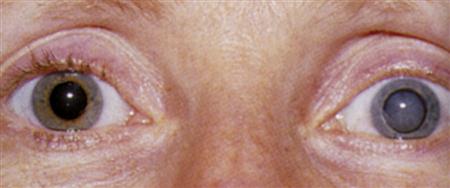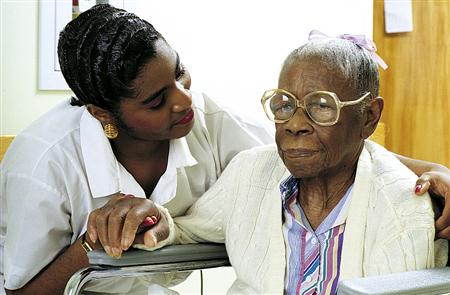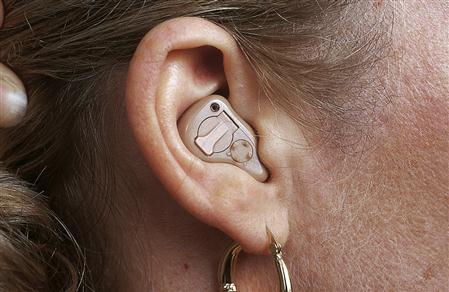Cognition and Perception
Objectives
1. Describe normal sensory and cognitive functions.
2. Describe how sensory perception and cognition change with aging.
3. Discuss the effects of disease processes on perception and cognition.
4. Describe methods of assessing changes in perception and cognition.
5. Identify older adults who are most at risk for experiencing perceptual or cognitive problems.
6. Identify selected nursing diagnoses related to cognitive and perceptual problems.
8. Discuss pain assessment and management as they relate to older individuals.
Key Terms
aphasia (ă-FĀ-zē-ă) (p. 181)
catastrophic reactions (p. 188)
cognition (KŎG-nĭ-tĭn) (p. 180)
confusion (k n-f
n-f ′uzh
′uzh n) (p. 185)
n) (p. 185)
delirium (dĕ- IR-ē-ŭm) (p. 187)
IR-ē-ŭm) (p. 187)
dementia (dĕ-MĔN-shē-ă) (p. 187)
dysarthria (d s-ĂR-thrē-ă) (p. 193)
s-ĂR-thrē-ă) (p. 193)
dysphasia (d s-FĀ-jē-ă) (p. 193)
s-FĀ-jē-ă) (p. 193)
hemianopsia (hĕm-ē-ŭn-ŌP-sē-ă) (p. 184)
intelligence (ĭn-tĕl′ -j
-j ns) (p. 180)
ns) (p. 180)
memory (mĕm′ -rē) (p. 180)
-rē) (p. 180)
otosclerosis (ō-tō-sklĕ-RŌ-sĭs) (p. 181)
perception (p r-sĕp′sh
r-sĕp′sh n) (p. 180)
n) (p. 180)
presbycusis (prĕz-bē-KŪ-sĭs) (p. 181)
presbyopia (prĕz-bē-Ō-pē-ă) (p. 181)
stimuli (S IM-ū-
IM-ū- i) (p. 181)
i) (p. 181)
sundowning (SŬN-doun-ĭng) (p. 188)
 http://evolve.elsevier.com/Wold/geriatric
http://evolve.elsevier.com/Wold/geriatric
The cognitive-perceptual health pattern deals with the ways people gain information from the environment and the way they interpret and use this information. Perception includes the collection, interpretation, and recognition of stimuli, including pain. Cognition includes intelligence, memory, language, and decision making. Cognition and perception are intimately connected to the functioning of the central nervous system and the special senses of vision, hearing, touch, smell, and taste.
Normal cognitive-perceptual functioning
The environment excites or stimulates the senses. The senses, in turn, pass these stimuli into the cerebral cortex, where recognition (perception) and interpretation (cognition) occur. Specific regions of the cerebral cortex are responsible for detecting and processing the stimuli acquired by the various senses. Malfunction of the sensory organs or of the interpretation centers in the brain results in disturbed perception and cognition.
If the senses do not function appropriately, stimuli do not enter the brain and there is not enough information for accurate interpretation. Individuals with sensory deficits in one area may attempt to compensate for these deficits by gathering more information from those senses that function normally. People with hearing deficits often lip-read or otherwise rely on visual cues. People with visual deficits rely more heavily on the senses of hearing and touch. People with multiple sensory deficits have great difficulty collecting information and often experience serious cognitive and perceptual problems. Adult hearing impairment has been associated with social isolation and depression. People with sensory deficits have a normal ability to think and learn, but for them, the process is more difficult. The story of Helen Keller’s life illustrates the difficulties experienced by a sensorially deprived person.
As discussed in Chapter 3, numerous sensory changes occur with aging. Common visual changes include farsightedness, caused by a loss of elasticity of the lens and resulting decrease in the power of accommodation (presbyopia); decreased ability to respond to changes in light, resulting in night blindness; and cataracts (Figure 10-1), which cloud the lens and result in blurred vision and sensitivity to glare. Common auditory changes include loss of hearing acuity, particularly of higher-pitched sounds (presbycusis); loss of hearing resulting from decreased sound transmission (otosclerosis); and ringing in the ears (tinnitus), which can be caused by Ménière’s disease, age-related changes, or medications. Older adults are increasingly susceptible to misperception and therefore misinterpretation when one or more of these changes are present.

Cognition, or thought, takes place in the cerebral cortex of the brain. Cognitive development starts at the time of birth and perhaps even earlier. When the human brain is repeatedly exposed to stimuli, connections develop between nerve fibers of the cerebral cortex. Each time stimuli are introduced to the brain, they are associated (at an unconscious level) with the pool of facts, memories, and experiences that are stored there. Once these connections are firmly established, information is said to be learned. Once learning has taken place, information or skills can be retrieved as needed. Memory enables people to retain and recall previously experienced sensations, ideas, concepts, impressions, and all information that has been previously learned. The human mind is extraordinary in its ability to learn and process extensive amounts of information. It is able to retrieve information on demand, correlate random pieces of information, make judgments, solve problems, and create ideas.
Cognition and Intelligence
We all have different levels of cognitive ability. People often speak of intelligence quotients (IQs) when they try to describe cognitive ability. However, IQ can be deceptive because there are different types of intelligence, and standardized testing procedures do not measure all types of intelligence.
Fluid intelligence is the ability to perform tasks or make judgments based on unfamiliar stimuli. This is sometimes referred to as the ability to “think on your feet.” Crystallized intelligence (often called wisdom) is the ability to perform tasks and make judgments based on the knowledge and experience acquired throughout a lifetime. Because young people have less knowledge and experience, they must rely more on fluid intelligence. With advanced age comes an abundance of skills and knowledge that has been acquired over time, and crystallized intelligence is used more often.
Intelligence is often measured by means of tests. Although intelligence tests are commonly used, they have distinct limitations. Most written tests measure verbal and mathematic ability. Thus, a person who has had little formal education can have a high level of cognition and yet score poorly on standardized intelligence tests. Cognition is not the same as education. Cognition is the ability to think and reason. Many people have good cognitive skills but poor education.
Intelligence tests are normally timed. Because all individuals do not process information at the same speed, two individuals with a similar pool of knowledge and skills may be judged very differently, simply because they respond at different speeds. Those with a rapid rate of information processing are typically judged more intelligent than those who take longer to process information, even if the end result is the same. This is probably reflective of our culture, which values speed.
Cognition and Language
Language is a product of cognitive function. In both spoken and written forms, language allows humans to communicate ideas and thoughts. Language develops early in life. By age 2, the average child has a vocabulary of several hundred words. Very specific areas of the brain are dedicated to language, and they change significantly as language skills improve.
Sensory and cognitive problems can result in poor language development or loss of language skills. Damage to the language centers of the brain can result in aphasia, a condition in which people are unable to understand or express themselves through language.
Aging persons commonly experience sensory changes that interfere with the collection of information. Visual and hearing changes, changes in taste and smell, and changes in touch and sensation all interfere with the ability to collect accurate information from the environment (Figure 10-2).

Many older people who are considered confused actually suffer from disturbed sensory perceptions. An older person who does not hear well (Box 10-1) or see well may walk into traffic or make mistakes about directions; these mistakes are not made because the individual is confused, but rather because he or she does not have enough sensory information to make an appropriate decision. Multiple competing stimuli can also cause problems if older adults are unable to focus on the important stimuli and disregard nonessential stimuli.
Intelligence does not automatically decrease with aging; the ability to learn does not either. Some people seem less intelligent as they age because of their tendency to be slower and more cautious in their responses. Rather than be embarrassed, older adults often take more time to be certain of the answer before they respond. This hesitancy or uncertainty may be mistaken for a lack of intelligence, which it is not.
Lack of formal schooling may make older adults appear less intelligent. They may lack polish in their speech and have a more limited vocabulary than do better-educated people. Many older adults who grew up in difficult times ended their formal educations at a young age because they had to work to help support the family. When today’s older adults entered the workforce, advanced education was not needed to earn a decent living. Many continued to read and learn and often exceeded what school would have provided. Still, these older adults may be intimidated by young, well-educated caregivers.
The speed at which information is processed and recalled changes with age. It is common for older adults to take longer to recall a specific piece of information. Short-term memory is more likely to be affected than is long-term memory. An older person who cannot remember what he or she had for breakfast may be able to describe in great detail an event that occurred 50 years ago.
Some degree of forgetfulness or memory loss is common with aging. This problem can be disturbing to the alert aging person. Many begin to fear that they are “losing their minds” or developing a serious problem. Careful assessment is needed to distinguish mild memory loss from an early indication of a more serious cognitive disorder.
There is no known reason why memory loss happens, but studies have shown that by 75 years of age, even an alert older person may lose as much as 30% of memory. The more memories a person has developed throughout life, the more he or she will retain, so well-educated older adults tend to retain a higher level of function than do less well-educated older adults. Even without formal education, many older persons are able to compensate for memory gaps by relying more on the large pool of experience gathered over a lifetime.
Nursing Process for Disturbed Sensory Perception
An older person can experience disturbances in one or more of the senses. The extent of these disturbances can range from very small changes to total loss of sensory function. The more serious the disturbance, the greater the risks are. Different nursing approaches are necessary for different types of sensory disturbances.
Assessment/Data Collection
Has the person mentioned any changes in the taste or smell of food?
• Can the person detect whether something is cold or warm?
• Can the person feel whether something is smooth or rough?
• Does the person see small details or shadows?
• Does the person frequently walk into or trip over objects?
• How close to the television does the person sit?
• Does the person wear eyeglasses? If yes, are they single-lens, bifocal, or trifocal?
• When was the person’s vision last checked?
• Does the person respond when people speak to him or her at normal volumes?
• Can the person hear a whisper from someone behind or to the side of him or her who cannot be seen?
• Does the person turn the volume of the television or radio to a very loud level?
• Does the person turn his or her head to hear?
• Does the person wear a hearing aid?
• Does the person respond appropriately or inappropriately to questions?
Box 10-2 lists risk factors for problems related to cognition and perception in older adults.
Nursing Diagnosis
Disturbed sensory perception: visual, auditory, kinesthetic, gustatory, tactile, olfactory
Nursing Goals/Outcomes Identification
The nursing goals for older individuals with disturbed sensory perception are to (1) demonstrate improved ability to detect changes in the environment, (2) interact appropriately with the environment, and (3) demonstrate the ability to compensate for deficits by using prosthetic devices and alternative senses.
Nursing Interventions/Implementation
The following nursing interventions should take place in hospitals or extended-care facilities:
3. Determine the best methods for communicating with older adults. Nurses must be patient and relaxed when working with older adults (Figure 10-3). When working with sensorially altered older persons, it is best to keep messages as simple as possible, use easily understood words, and speak clearly. It may be necessary to reword a statement if the first attempt is not understood. When explaining care or treatments, nurses must be careful to avoid information overload. When writing messages, they should ensure that the writing is clear and large enough to be seen easily.
When dealing with older adults who are hearing-impaired, it is helpful to speak in a low tone of voice because hearing losses are usually in the higher frequencies of sound. Because many hearing-impaired people compensate by lip-reading, it is best to stand in good light while facing the person and to speak slowly but not unnaturally so. Nurses must not chew gum or eat while conversing. If one of the older person’s ears is better than the other, talking into the good ear may help. Background noise from television or radio should be kept to a minimum because it may distract older adults or interfere with verbal communication.
Facial expressions, gestures, and other visual cues that are appropriate to the message should be used. These cues can help the person understand what the nurse is talking about. For example, if the nurse’s intended message is “Please come with me,” the nurse can hold out his or her hand and begin to walk. If it is time to groom someone’s hair, the nurse can show the person the brush and comb to help make the message clear.
Persons with hearing impairments are not likely to understand messages spoken through the call signal speakers that are used in most care settings. In most facilities, even people with good hearing have problems with these devices. Caregivers should respond promptly and in person to calls from the sensorially impaired. More information regarding communication with older adults is provided in Chapter 5.
4. Modify the environment to reduce risks. Lighting is important for older adults. Because it takes the eye longer to adjust to bright light as we age, stairs and other hazardous areas should be designed to prevent glare. When an older person has a condition in which a portion of the visual field is lost (hemianopsia), the furniture should be arranged to maximize the person’s ability to see (Figure 10-4). Personal belongings should be placed toward the good side, and the person should be taught to turn his or her head and “sweep” the environment to pick up more visual cues.
Eyeglasses must be cleaned regularly. Fingerprints and other debris can distort vision and make the glasses useless. To be of benefit, eyeglasses must also fit the person properly. Many glasses are too loose and slide down the nose; others are too snug and create uncomfortable pressure areas on the nose or ears. Often, older adults wear glasses with broken frames that are taped together. If the glasses do not help vision or they are uncomfortable, older adults are likely to avoid wearing them. Nurses should arrange a consultation with an eye specialist to get such problems corrected.
Hearing aids are worn by many older persons. These devices do not duplicate normal hearing and are not beneficial for everyone. Hearing aids can be built into eyeglasses or inserted into the ear canal. Some of the older units hang over the external ear; newer models are almost invisible when worn (Figure 10-5).
Many persons have difficulty adjusting to hearing aids and complain that they are bothersome. When first fitted with a hearing aid, the person may be able to tolerate it only for a few minutes a day. As the person adjusts to the device, the amount of time it is worn should be gradually increased. Older persons who are adjusting to wearing a hearing aid often report that it makes them nervous or jumpy to hear so many sounds. They should be reassured that this is normal and that the jumpiness will go away as they become used to wearing the hearing aid. Many people who wear hearing aids report that the sounds they hear are “tinny” or “noisy” and that they hear feedback whistles or hums. These noises are usually caused by incorrect insertion or improper adjustment of the controls on the device.
Hearing aids require a certain amount of care and maintenance. Because they are fragile, care should be taken not to drop them. Most are made of plastic and should be kept away from very hot or very cold places. Before being inserted into the ear, hearing aids should be checked for cracks or rough edges that could injure the ear. The ear mold should be cleaned regularly. Special attention should be paid to the removal of cerumen, which may plug the canal and reduce the effectiveness of the device. Batteries should be checked and changed regularly because the hearing aid will not work properly without a good power source. To prolong the life of the batteries, the hearing aid should be shut off when it is not in use. Batteries should be checked for corrosion and contacts should be cleaned, particularly if the device becomes wet. Storing unused batteries in the refrigerator can prolong their life. Old batteries should be discarded after a change so that they are not mistakenly saved and reused. This mistake can lead to confusion and frustration.
Caregivers who are not familiar with hearing aids should receive special training in how to place them in the ear canal properly. Hearing aids are useless unless they are worn properly. Nurses should always verify that a hearing aid has been applied to the correct ear. If the person wears two aids, they should be marked so that the correct device is placed in the correct ear. If the device still does not function properly, nurses may need to consult with an audiologist or speech therapist. If the older person is reluctant to wear the hearing aid, the nurse should do a thorough assessment to determine why he or she is refusing. A thorough reevaluation of hearing may be necessary.
The following interventions should take place in the home:
Use of contrasting colors helps older adults determine edges and borders. Contrasting strips should be applied to areas where there is a change in elevation, such as shower entrances and steps. Contrasting door frames, dishes, pillows, personal care items, and toilet seats will help older adults distinguish these items more easily.
2. Assist sensorially impaired persons in developing techniques or acquiring devices that will help compensate for losses.
Hearing-Impaired Persons. Nurses should explain ways that hearing-impaired persons can improve communications. These include (1) telling others that they are hard of hearing, (2) focusing on the speaker and paying attention to what is being said, (3) facing the speaker or asking the speaker to face them, (4) asking the speaker to speak slowly and clearly but not to shout, and (5) asking the speaker to repeat when information is not clear.
Many special devices are available for hearing-impaired persons. Local telephone companies can provide special equipment such as amplifiers or video display terminals that enable older adults to maintain contact with others. Doorbells and mats that flash a light when someone is at the door are available. Alarm clocks that vibrate rather than ring can be purchased from specialty or department stores. Hearing-impaired individuals with adequate vision should be made aware of closed-caption television broadcasts, which provide typed narration of news and many entertainment programs.
Visually Impaired Persons. Telephone dials can be modified with overlay rings that have large numbers to assist in dialing. Most newer telephones can be programmed with commonly used numbers so that the person needs to push only one button to dial. Handheld or floor standing magnifying devices help with reading or close work. Large-print books and magazines are available in most public libraries. Written materials can also be enlarged on photocopy machines to make reading easier. Books on audiotape are also available in stores and many libraries. Talking clocks that fit in a pocket are available.
Nursing Process for Disturbed Thought Processes
Anything that damages or interferes with the normal functioning of the cerebral cortex can result in cognitive (i.e., thinking and judgment) problems. All changes in cognitive function must be given immediate attention. Prompt assessment of the type and severity of the disorder, along with identification of the cause or causes, enables the caregiver to plan the most appropriate interventions for each individual. Cognitive function can be affected by sensory changes, physiologic factors, or emotional disorders. Cognitive problems can range from mild and reversible forms of disorientation to severe and irreversible forms of dementia. Depression, hypothyroidism, and vitamin deficiencies are common treatable causes of pseudodementia (Box 10-3).
Sensory changes can result in behaviors that mimic cognitive problems but actually are not. The two should not be confused. Sensory misperception should be ruled out before further cognitive assessment is performed.
< div class='tao-gold-member'>
Stay updated, free articles. Join our Telegram channel

Full access? Get Clinical Tree






